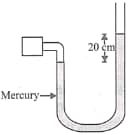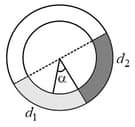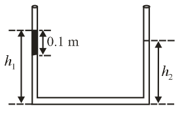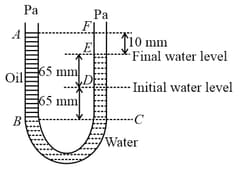A manometer reads the pressure of a gas in an enclosure as shown in the figure. What is the absolute and gauge pressure of the gas in of mercury ? (take atmospheric pressure = of mercury)

Important Questions on Thrust and Pressure


Two liquids of densities and are filled up behind a square wall of side as shown in figure. Each liquid has a height of The ratio of the forces due to these liquids exerted on upper part to that at the lower part is (Assume that the liquids are not mixing):
A cylindrical vessel containing a liquid is rotated about its axis so that the liquid rises at its sides as shown in the figure. The radius of vessel is and the angular speed of rotation is . The difference in the height, of liquid at the Centre of vessel and at the sides of the vessel will be :

An open-ended U-tube of uniform cross-sectional area contains water (density ). Initially the water level stands at from the bottom in each arm. Kerosene oil (a water-immiscible liquid) of density is added to the left arm until its length is , as shown in the schematic figure below. The ratio of the heights of the liquid in the two arms is

[Take, density of water ]
A barometer is constructed using a liquid (density ). What would be the height of the liquid column, when a mercury barometer reads
(density of mercury )
A cylindrical block of wood (density = ), of base area and height , floats in a liquid of density . The block is depressed slightly and then released. The time period of the resulting oscillations of the block would be equal to that of a simple pendulum of length (nearly) :


